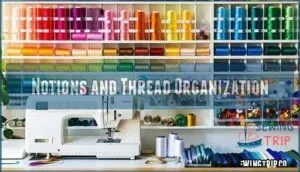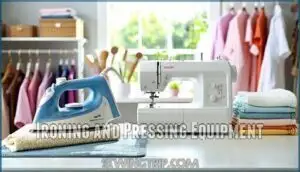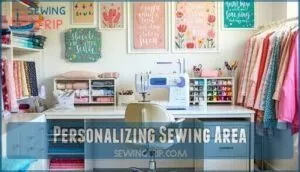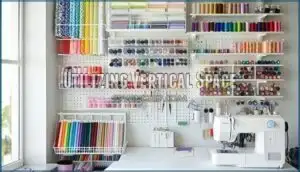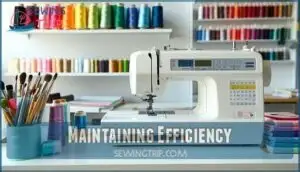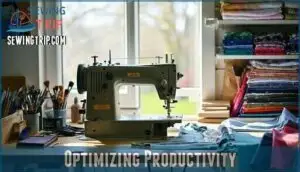This site is supported by our readers. We may earn a commission, at no cost to you, if you purchase through links.

Start with proper lighting and a comfortable cutting height. Keep your most-used tools within arm’s reach of your machine.
Use clear containers for thread and notions so you can grab what you need quickly. Create dedicated zones for cutting, pressing, and storage.
Store fabric vertically like files so you can see everything at once. These essential sewing room tips transform chaos into creativity.
The real magic happens when you customize your space to match your unique sewing style and discover the unexpected storage solutions that’ll change everything, leading to a space that fosters productivity.
Table Of Contents
Key Takeaways
- Design your workspace for efficiency – Position your cutting table at the right height, add proper lighting, and keep your most-used tools within arm’s reach of your sewing machine to prevent constant movement and strain.
- Organize supplies with visibility in mind – Use clear containers for thread and notions, store fabric vertically like files, and implement labeling systems so you can grab what you need quickly without searching.
- Create dedicated zones for different tasks – Set up separate areas for cutting, pressing, and storage to maintain a smooth workflow and prevent workspace chaos during projects.
- Maximize vertical space with smart storage – Install pegboards for tools, wall-mounted containers for supplies, and hanging organizers to keep everything accessible while freeing up valuable work surface area.
Setting Up Space
Your sewing room setup determines how much you’ll enjoy every project you tackle.
A well-organized workspace makes sewing feel effortless instead of exhausting.
Start with smart space planning and essential furniture choices to create a workspace that makes sewing feel effortless instead of cramped.
Allocating Room for Sewing
Start by measuring your available space and marking clear boundaries for your sewing area. Consider room dimensions carefully – even small spaces work with smart space prioritization.
A dedicated area beats constantly moving supplies around multi-purpose rooms. Plan your ergonomic layout before buying anything.
This foundation makes sewing room organization and efficient sewing space design possible from day one.
Choosing Essential Furniture
Invest in ergonomic chairs that support your back during long sewing sessions.
A proper cutting table prevents hunching over fabric.
Storage units keep supplies organized and within reach.
Choose an adjustable ironing board for comfort.
Add a dress form for fitting garments.
Consider using an ergonomic chair option for enhanced comfort.
Smart sewing room organization starts with functional furniture that makes your sewing space design efficient and comfortable.
Selecting Proper Lighting
Good lighting makes the difference between squinting through projects and sewing with confidence.
Natural light from windows provides the best color accuracy for matching threads and fabrics.
Add task lighting with LED bulbs that offer adjustable light temperature settings.
Position lights to reduce glare on your work surface.
Proper sewing room lighting prevents eye strain during long sessions and is essential for color accuracy.
Organizing Storage Solutions
Smart fabric storage solutions start with clear containers and labels. You’ll want dedicated spaces for thread organization and pattern storage. Tool storage keeps essentials within reach while supply inventory tracking prevents duplicate purchases.
A 3-tier rolling cart can add mobility to your storage.
- Fabric Storage: Use clear bins sorted by color and fabric type for quick project selection
- Thread Organization: Install spools on pegboards or use drawer organizers for easy access
- Pattern Storage: File patterns in binders or hanging folders with project photos attached
Essential Tools Needed
You’ll need the right tools to make your sewing room work efficiently. Start with a reliable sewing machine, proper cutting tools, organized thread storage, and quality pressing equipment.
Sewing Machine Selection
Choose your sewing machine based on Motor Power and Stitch Options that match your projects.
Compare brands like Singer, Brother, and Janome for reliability. Explore different sewing machine brands before making a decision.
Consider Budget Considerations carefully – entry-level machines cost $100-300, while computerized models reach $800.
Machine Features like automatic threading save time. Research sewing machine maintenance requirements before buying to guarantee long-term value.
Notions and Thread Organization
Beyond the sewing machine, Thread Storage and Bobbin Organization keep your workspace functional.
Create a Notion Inventory with Color Coding systems for easy access. Use clear containers for thread storage and implement Labeling Systems for quick identification.
Organize bobbins by color or project. Sewing notion kits offer a convenient solution for beginners.
These sewing storage ideas prevent thread tangles and save time during projects, utilizing effective Labeling Systems.
Measuring and Cutting Tools
Accurate measuring and cutting tools form the backbone of successful sewing projects.
You’ll need fabric scissors that stay sharp, rotary cutters for straight lines, and measuring tapes that don’t stretch.
Self-healing cutting mats protect your surfaces while seam rippers fix mistakes quickly.
Consider blade material options for different fabrics.
Smart sewing tools organization keeps everything within reach, making your sewing room layout efficient and productive.
Ironing and Pressing Equipment
Your pressing station transforms flat fabric into professional results.
Modern steam irons with 400 steam holes and 210g/min output speed up work.
Wool pressing mats insulate heat on both sides for sharper seams.
Position your ironing station next to your sewing machine for smooth workflow.
Store specialty tools like clappers and iron shoes within reach for quick access.
To achieve flatter quilt blocks, remember to use dry pressing techniques.
Customizing Workspace
Now that you’ve sorted your tools, it’s time to make your workspace truly yours. A personalized sewing room boosts both comfort and creativity while keeping you motivated for long projects.
Personalizing Sewing Area
Your sewing space should reflect your personality and style preferences.
Color palettes set the mood while theme decor creates visual harmony.
Ergonomic seating supports long crafting sessions.
Music ambiance enhances creativity during projects.
- Choose colors that inspire your creativity and match your home’s aesthetic
- Install proper sewing tools organization systems for easy access to supplies
- Select comfortable seating that supports good posture during extended sewing sessions
- Create display areas to showcase finished projects and motivate future work
Adding Decorative Elements
Decorative touches transform your workspace into a creative haven.
Display vintage sewing tools as art pieces, hang colorful thread spools on pegboards, and add fabric swatches to inspiration boards.
Choose pin cushion ideas that double as sewing room decor.
Consider applique designs on storage containers and embellishment techniques for organizing supplies creatively.
Incorporating Inspirational Materials
Inspiration boards transform your workspace into a creative haven.
Pin fabric swatches, color palettes, and design books above your cutting table.
Create mood boards with project planning sketches and creative prompts.
These visual cues spark ideas when you’re stuck.
Your sewing room decor becomes a gallery of possibilities that keeps creativity flowing.
Utilizing Vertical Space
Walls hold untapped potential for your sewing room organization.
Smart vertical storage transforms cramped spaces into efficient work areas that keep supplies accessible yet organized.
- Wall storage systems with adjustable shelves maximize every inch of available space
- Hanging organizers with clear pockets keep thread spools and small notions visible
- Pegboard systems allow customizable tool placement that adapts to your changing needs
- Stackable containers mounted on walls store fabric scraps while maintaining easy access
To maximize visibility, consider the benefits of natural light.
Maintaining Efficiency
You can transform your sewing space from chaotic to efficient with smart workflow strategies. These proven methods will help you complete projects faster while reducing stress and mistakes.
Streamlining Sewing Process
Workflow efficiency transforms scattered efforts into seamless productivity.
Start with batch cutting all pieces before touching your machine.
Use chain piecing to connect fabric segments without stopping between seams.
Create an ergonomic setup with proper chair height and machine positioning.
Organize your pressing workflow by keeping the iron within arm’s reach.
Smart storage keeps essentials accessible, and this contributes to overall workflow efficiency.
Implementing Time-Saving Techniques
Batch Cutting identical pieces saves setup time by 40%.
Chain Piecing keeps your machine running without stopping to cut thread between seams.
Pre-Planning Projects with digital patterns eliminates paper prep.
Keep multiple bobbins wound and organize your needle storage within arm’s reach.
Efficient Ironing stations beside machines prevent workflow interruptions.
To further streamline the process, consider labeling fabric pieces immediately after cutting, which involves Batch Cutting, Chain Piecing, and Pre-Planning.
Managing Fabric and Supplies
Smart fabric storage keeps your sewing room organized and efficient.
Smart fabric storage transforms chaos into creative flow effortlessly.
Use clear bins to sort fabrics by color or project type. Label everything for quick identification.
Create a supply inventory list to track thread management and notions. Store cutting scraps in designated containers for future use.
Implement bobbin storage systems and needle storage solutions near your workspace. Organize pin cushion ideas by keeping them within arm’s reach of your cutting area.
Minimizing Distractions and Interruptions
Your organized fabric storage won’t help if distractions constantly pull you away from projects. Creating boundaries transforms your sewing experience from scattered to focused.
Establish clear Dedicated Hours when family knows you’re unavailable. Set Family Boundaries by communicating your sewing schedule. Your comfortable sewing chair becomes a sanctuary when you:
- Limit Notifications by silencing phones and closing unnecessary browser tabs
- Declutter Workspace regularly to maintain visual calm
- Use Noise Cancellation headphones for concentration
- Position your ergonomic sewing setup away from high-traffic areas
These sewing room tips create the focused environment serious sewers need.
Optimizing Productivity
You’ll maximize your sewing productivity by establishing clear schedules and realistic deadlines that fit your lifestyle.
Smart goal-setting and motivation techniques keep you focused while preventing burnout from overly ambitious projects, utilizing motivation techniques effectively.
Creating Sewing Schedule
Block out specific times for each sewing task to maximize your productivity.
Use timeboxing tasks to dedicate focused periods for cutting, stitching, and finishing.
Build in buffer time between projects and maintain schedule flexibility for unexpected adjustments.
Consider batch sewing similar items together while ensuring your ergonomic sewing setup supports longer work sessions effectively.
Addressing bottleneck identification can further refine your scheduling.
Setting Realistic Goals and Deadlines
Your project dreams need realistic timelines to succeed.
Unrealistic deadlines create stress and hurt your sewing room experience.
Consider these priority factors:
- Project Scope – Match timeline to garment complexity
- Skill Assessment – Account for your current abilities
- Time Management – Block dedicated sewing hours weekly
- Deadline Flexibility – Build buffer time for mistakes.
Prioritization techniques help balance multiple projects while maintaining a user-friendly design approach in your sewing room layout.
Staying Motivated and Focused
Many sewists find their motivation wanes when projects pile up.
Combat Procrastination by breaking tasks into small wins. Celebrate Milestones with a Reward System that keeps you engaged.
Find Inspiration through online communities or sewing room layout changes. Join Community groups for player engagement and support.
These strategies boost player satisfaction and maintain focus during challenging projects.
Frequently Asked Questions (FAQs)
What not to do in a sewing room?
Don’t eat or drink near your fabric – spills create permanent stains.
Avoid cutting on surfaces without proper mats.
Don’t store sharp tools loosely in drawers where they’ll dull or cause injury.
What do you need for a sewing room?
Ninety percent of seamstresses report better productivity with organized spaces.
You’ll need a sturdy cutting table, good lighting, comfortable chair, storage solutions, and basic tools.
Don’t forget measuring tape, scissors, seam ripper, and pins for your creative journey.
How to kit out a sewing room?
You’ll need a sturdy cutting table, good lighting, ergonomic chair, and organized storage for fabrics and tools.
Add a design wall, pressing station, and power outlets for machines to create an efficient workspace.
How to organize a tailoring room?
Create designated zones for cutting, pressing, and storage. Use pegboards for tools, clear bins for supplies, and proper lighting at your workstation. Label everything clearly for quick access.
How do you prevent fabric from fraying quickly?
Use pinking shears to cut zigzag edges that resist unraveling.
Apply fray check liquid along cut edges and let it dry completely.
Serge or overlock raw edges with your machine for professional finishing.
Whats the best way to remove stubborn stains?
Treat fresh stains immediately with cold water and blot gently. For set-in stains, pre-treat with enzyme detergent or make a paste using baking soda and water before washing normally.
How often should you clean your sewing machine?
Your sewing machine’s like a car – it’ll break down if you ignore it completely.
It needs to be cleaned after every major project or every 8-10 hours of use to keep it running smoothly.
Can you sew stretch fabrics on regular machines?
You can sew stretch fabrics on regular machines, but you’ll need the right needle and stitches.
Use a ballpoint needle to prevent snags.
Choose zigzag or stretch stitches instead of straight seams for flexibility.
What causes thread to keep breaking while sewing?
Thread breaks happen when it’s pulled too tight, you’re using the wrong needle size, or your thread quality is poor.
Check your tension settings, match needle size to fabric weight, and use quality thread for smooth sewing.
Conclusion
Skillfully structured spaces separate success from sewing struggles.
These essential sewing room tips transform your workspace into an efficient creative haven.
You’ll find that proper organization saves time and reduces frustration during every project.
Your cutting table height matters as much as your lighting quality.
Thread storage systems keep supplies visible and accessible.
Vertical fabric filing prevents waste and speeds selection.
Clean zones for pressing and cutting maintain workflow momentum.
Smart storage solutions maximize small spaces effectively, ensuring a clean and efficient workspace with efficient creative elements.
- https://www.diaryofaquilter.com/organize-your-sewing-room/
- https://www.stringandstory.com/blog/organized
- https://www.aquiltinglife.com/sewing-room-ideas-and-organization/
- https://www.clinicalcasereportsint.com/open-access/ergonomic-evaluation-of-workstation-for-sewing-machine-operators-in-ethiopia-9501.pdf
- https://www.slideshare.net/slideshow/ergonomics-in-the-sewing-room/55696877



